Imagine becoming so successful that your product becomes synonymous with its application. Joining names like Bubble wrap, Frisbee and Biro, Muc-Off has become the go-to cleaner for mud-encrusted riders around the globe. But with success come new challenges.

Since its inception in 1994, Muc-Off’s hot-pink, iconic cleaner has been used by almost every core biker in the pursuit of a clean bike. However, success can be a double-edged sword. Yes, you may have an iconic product, but sometimes it’s hard to be recognised for anything else. As near to a household name as you can get in the bike sector, Muc-Off have been broadening their product portfolio for many years. However, in highly contested sectors like tubeless, you can’t hope to compete with mediocre products. You have to go above and beyond to claim your piece of the pie. We took a trip to Muc-Off H.Q. to learn how they broke out of their hot-pink mould.
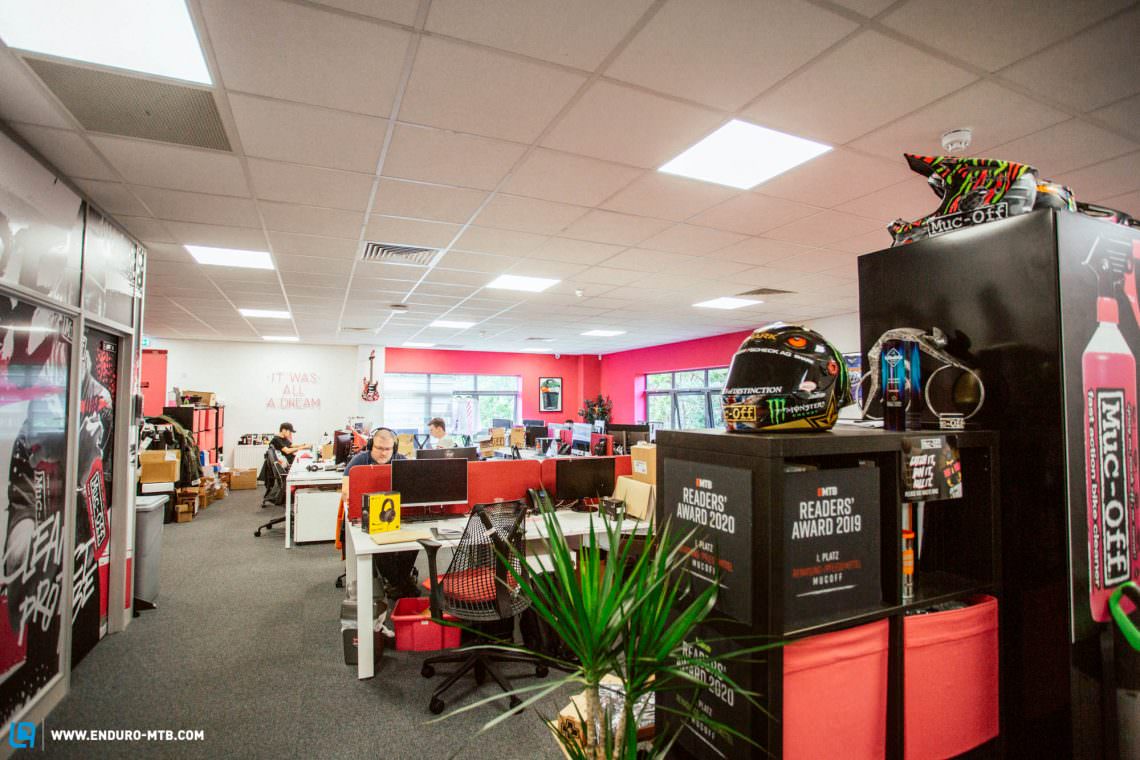
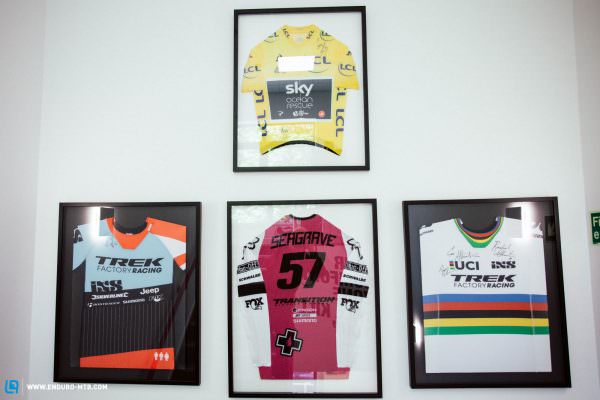
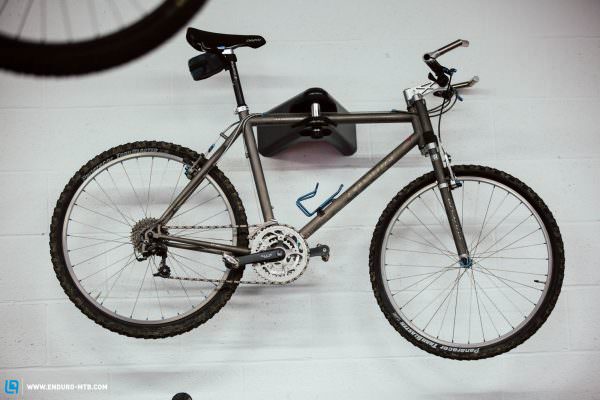
“Oh, is this it?” Google Maps insisted that we had reached our destination, but we had expected something bigger. Muc-Off H.Q. is unassuming, tucked away in the corner of an off-beat commercial estate in Poole, UK. Any doubts that we were at the right place evaporated when we noticed the neon glow of the hot pink walls through the doors. Like most of the industry, Muc-Off’s sales have been booming and the offices buzz with activity, new staff, new products and new energy. Growing from humble beginnings, Muc-Off have a backstory entwined with the growth of mountain biking as a sport and represents a true U.K. success story. Leading the charge on cleaning up their act with Project Green, the brand goes beyond green-washing by making tangible benefits through the use of more recycled materials, biodegradable formulas and optimising their overall business. However, this is a story all of its own and not the reason we are here.

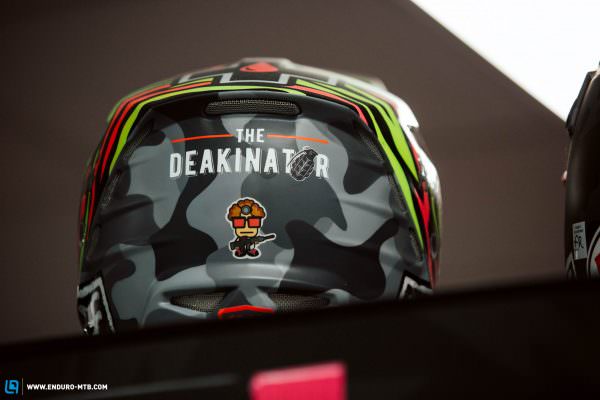

We are here to see first-hand how Muc-Off develops their products in house. Just a short walk down the road to their R&D facility and things take a turn for the scientific. The unit is small and crammed full of equipment but buzzes with an activity that suggests it’s a place where stuff gets done. Continuously evolving, the lab is currently focussed on optimising chains for this year’s Grand Tours. Borosilicate laboratory jars of lubricant crowd the immaculate worktops, each labelled with a different batch number and title. Expensive scanning microscopes compete for desk space with test rigs and bag upon bag of meticulously labelled aluminium material samples. If it wasn’t for the retro bikes hanging from the ceiling or the signed skate decks, we could easily be in a pharmaceutical laboratory. In the centre of the room, a drivetrain test rig whirs tirelessly away, the chain whipping around while a dynamometer unrelentingly records hundreds of parameters, measuring input and output loads and crucially, the loss of the system.

When it comes to drivetrain efficiency, it’s always losses unfortunately, but it’s how you can minimise them that counts. – *
Hundreds of pro-team chains sit dripping next to the rig, worn and abused. The rig allows the research team to test lubes against specific geometries and weather conditions, and accurately recreate race stages using athletes’ power data. The proof is in the pudding, as Muc-Off’s treated chains are used by some of the best teams of the Tour de France, like Team Sky and now Team Ineos and EF Eduction-NIPPO. “A new chain is not a fast chain,” explains their R&D technical director. “We run each new chain on the dynamometer to measure its performance, then through a series of ultrasonic cleans and washes. Once we remove all the stock oil-based lubricants, we apply our own Nanotube technology. These tubes fill the microscopic gaps and ridges on the metal chains, ensuring smoother running.”

Sensing our “marketing bullshit” radars have been activated, we’re led to a complex scanning microscope called a Contour White-Light Interferometer, accurate to one thousandth of a nanometre (that’s 0.000000001 millimetres) and the results are startling. Looking at a brand new chain at this resolution looks more like a topographical representation of the alps, full of gigantic peaks and valleys in the seemingly smooth metal surfaces. “This is where the additives in the lube come in. Most people think it’s to keep the lube on and stop it flicking off, but actually, it’s to fill up these imperfections and provide a smoother surface.” For fun, we also compare the surfaces of brand new Shimano and SRAM chains – the differences are stark.
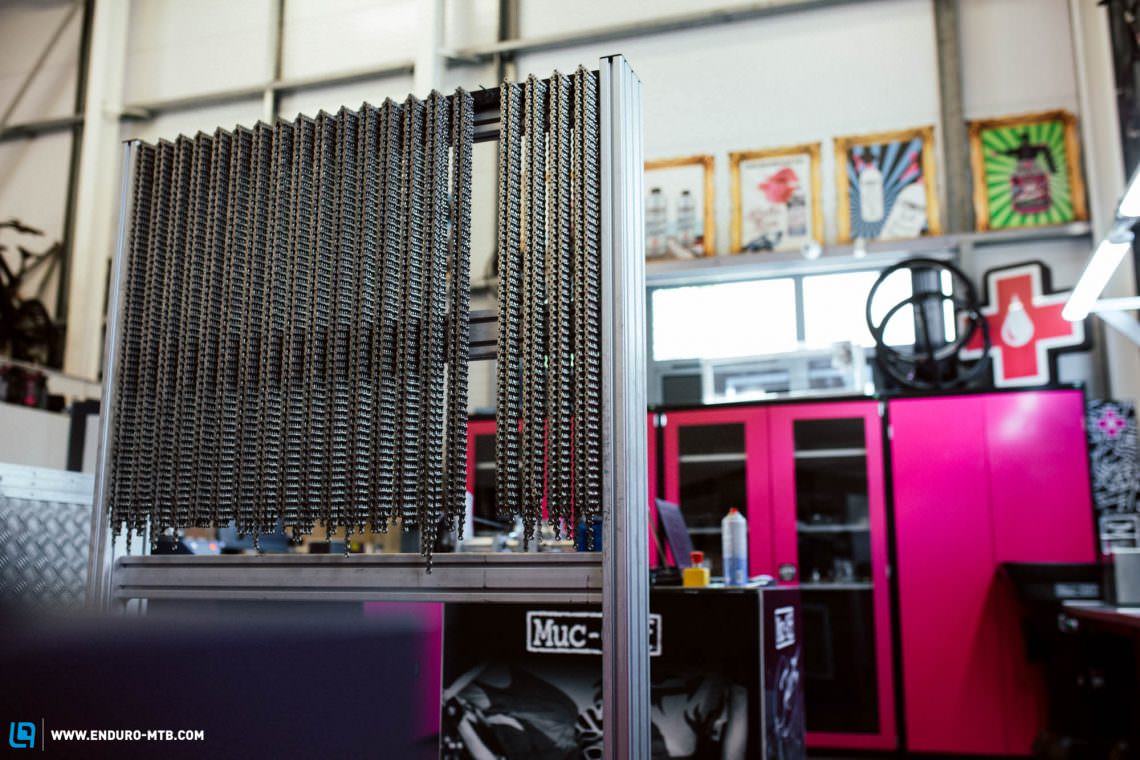
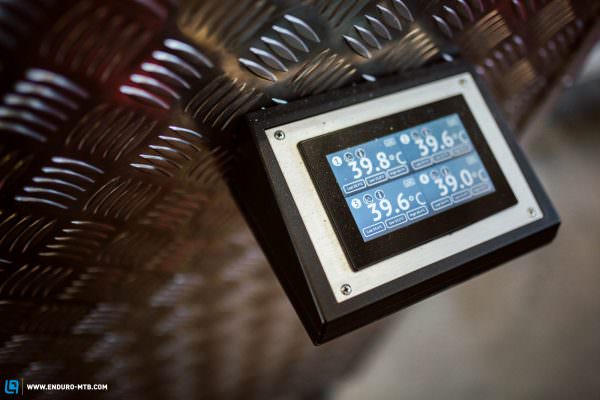
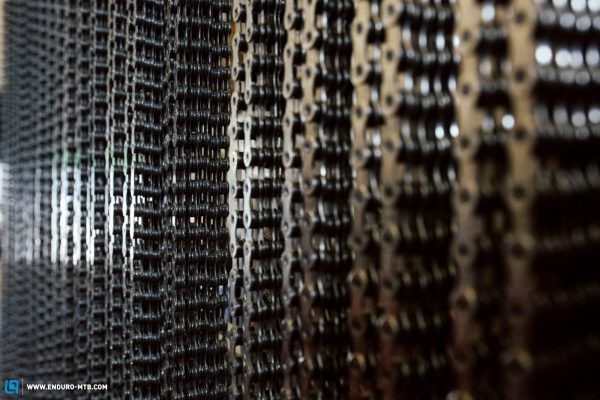
As we talk, another expensive-looking machine quietly measures the coefficient of friction of a test sample, with and without lube. Every possible drivetrain coating has been tested and explored on this machine – one test sample on the desk is also used on space rockets. While this level of scrutiny is more targeted at the world of watt-hunting, calorie-counting road racing and not of huge interest to the average mountain biker grinding up a gruelling climb in the rain, it means you can rest easy that the lube you use is backed by the knowledge that Muc-Off has gained.
As we slip deeper into this Willy Wonka bike nerdfest, we almost forgot what we came for. How did Muc-Off go about producing their new PIM (Prepare, Inflate, Maintain) tubeless range? For Muc-Off, it started with sealant. As we all know, there’s nothing more annoying than popping off your tyre after a few months’ use only to find a vast coagulated rubber ball rolling around inside. Knowing that their No Puncture Hassle sealant would have to live up to its name, they trialled over 50 different formulas using synthetic latex and natural latex, balancing antifreeze elements with drying time. A colossal oven dominates the lab floor and helped determine drying times at temperatures from the Arctic to the Sahara. With a shortlist of formulas compiled, the really tough work began, testing them against the hundreds of different tyre compounds and sidewall materials on the market. “We wrote off so many nice t-shirts when stab-testing the tyres on the trails,” a product developer laughs.

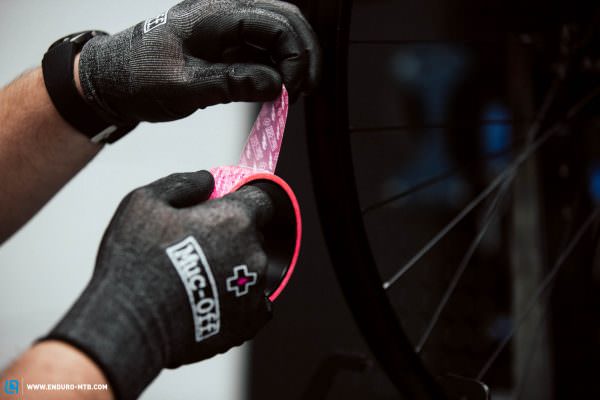
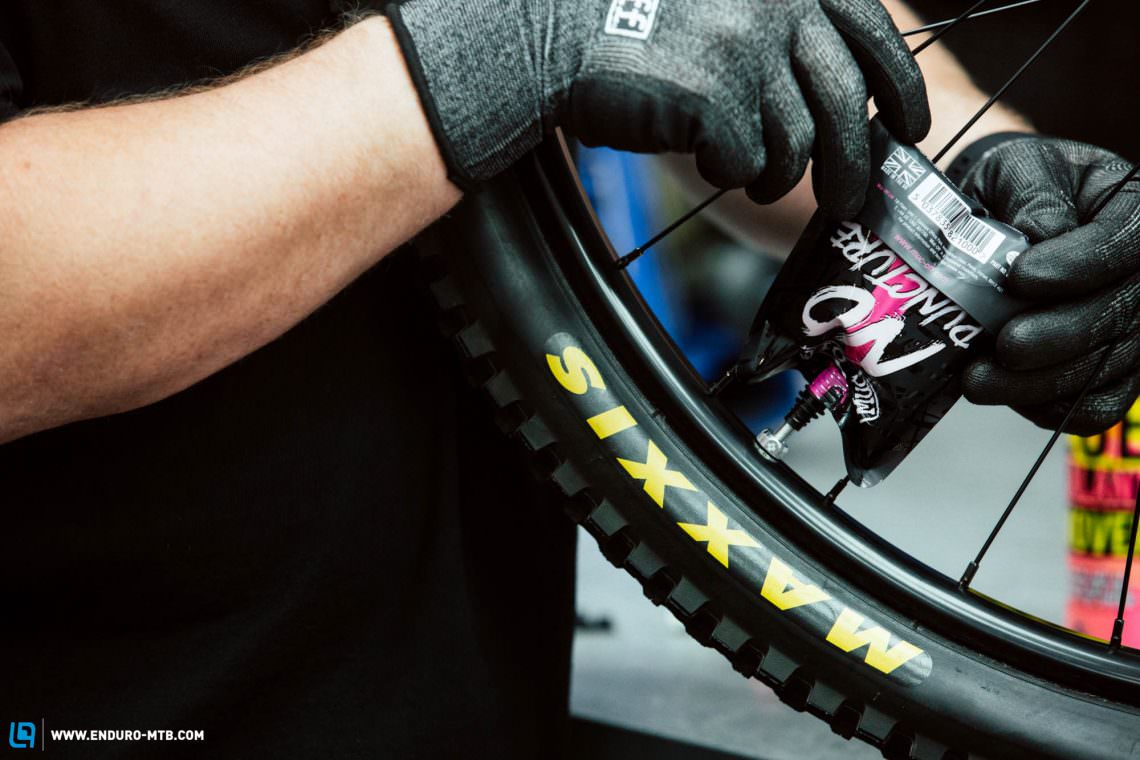
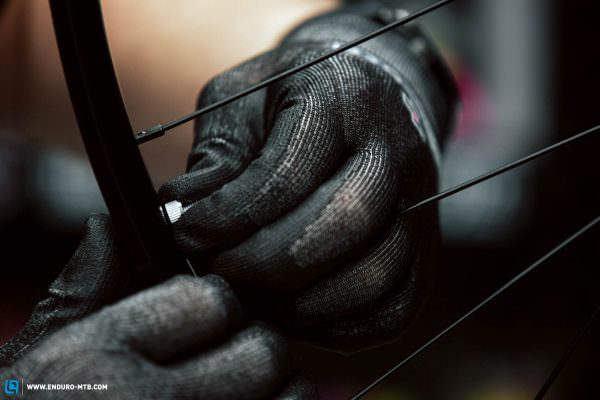
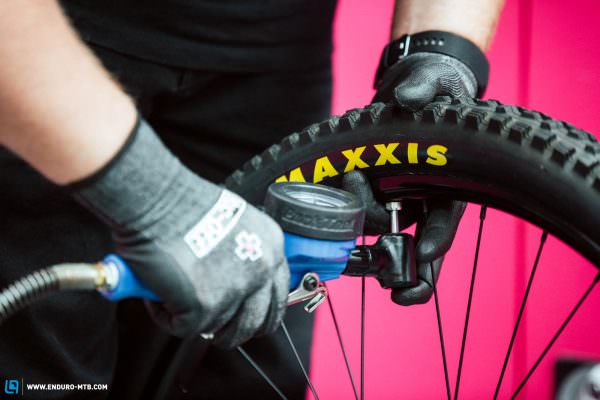
On one side of a huge whiteboard is a complex equation of hydrodynamics and coefficients of friction, on the other side is a flat-screen TV for streaming the downhill world cup. – *
If any product defines Muc-Off’s attention to detail, it’s their new tubeless valves. On the surface, simple – just valves. But dig a little deeper and you start to realise there’s a lot of no-nonsense tech. Yes, the 6 channels in the valve stem base allow air to circulate past a tyre insert. And anyone who has struggled to free off a jammed valve lock ring with nothing but swear words and blind hope will be thankful for the valves’ internal 4 mm machined Allen key slot for easier removal. Then there’s the core-removal tool hidden in the spare alloy cap and the three different rubber grommets for different rim profiles. Small details, yes, but once you’ve seen them, you think, “Shit, yes, why don’t all valves have that?” The fact that they come in 10 different colours (and 3 lengths) delivers the knockout blow.
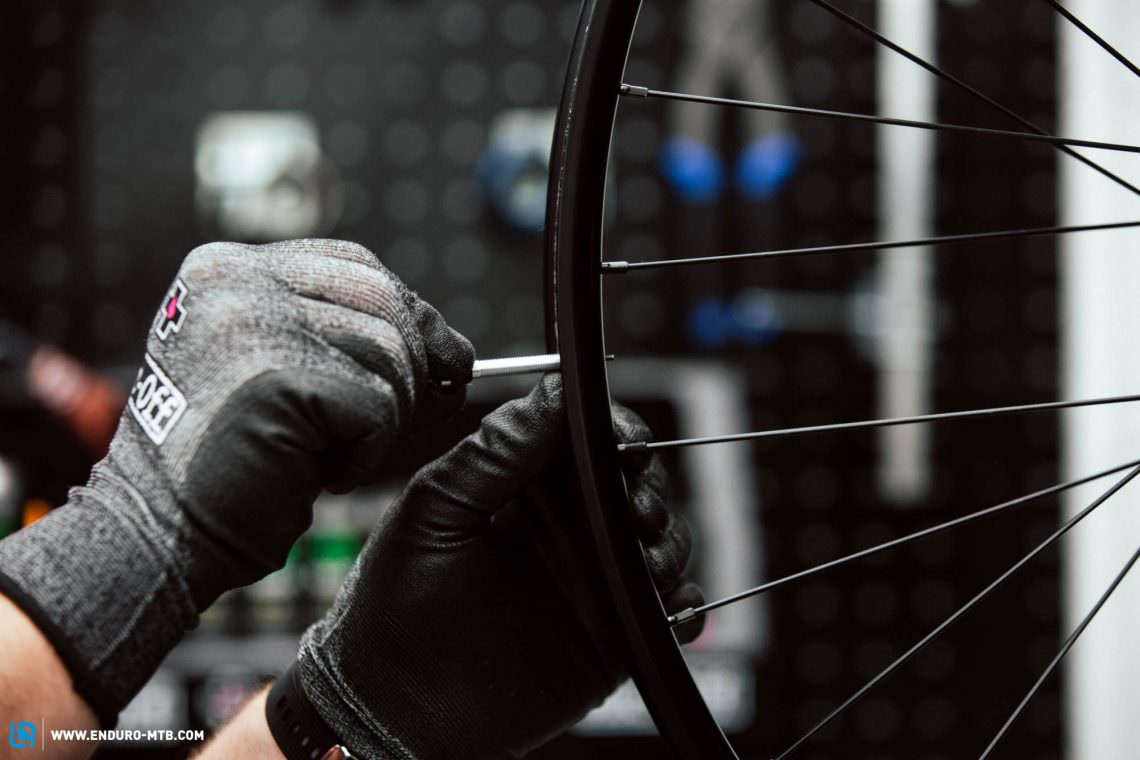
You should never stop testing. Here at Muc-Off, we are always at the front of the queue, products are conceptualised and tested, all in-house. It never stops. – *
Tight word counts leave us with many questions unanswered. While we weren’t sure what to expect from a visit to Muc-Off H.Q., what we discovered was obsessive attention to the smallest details and a culturally embedded approach to in-house testing and product development. While their products may not elicit the same enviable glances from other riders as the latest high-pivot idler bikes, Muc-Off rest safe in the knowledge that their sealant will last longer and their lube will keep your chain running smoother. They know because they’ve tested it.
* Muc-Off have asked us not to name their resident tribologists and product developers.

Did you enjoy this article? If so, we would be stoked if you decide to support us with a monthly contribution. By becoming a supporter of ENDURO, you will help secure a sustainable future for high-quality mountain bike journalism. Click here to learn more.
Words & Photos: Trevor Worsey









